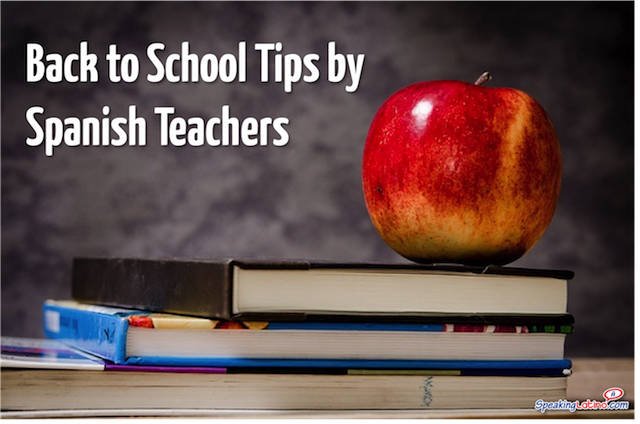
The “back-to-school” period is an exciting time – you are rested, renewed and full of energy to tackle a new year and help your students fall in love with the Spanish language. It’s a great time to plan out the entire school year, and you can even use the fact that everyone is still getting used to being back at school to try out new ideas instead of throwing your students into deep waters right away!
Thanks to a group of Spanish teachers who volunteered their time to speak with us over the last couple of weeks, Diana and I heard a variety of fabulous ideas that we want to share with you. I guarantee that you will implement at least one or two when teaching Spanish.
Also, we discovered that there are some amazing resources available that many teachers don’t know about, which we will also share here.
12 Back-to-School Tips by Spanish Teachers
So here’s our list of Back-To-School Spanish Teachers Tips:
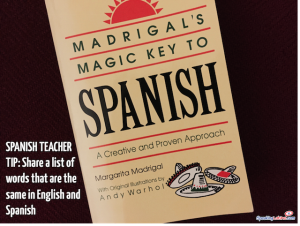
1. Share a List of Cognates
The idea of learning a new language, especially one you either had no or minimal contact with, can, but doesn’t have to, be overwhelming. This is especially true for a language like Spanish, which has more to do with English than the students might think.
To calm their fears, on the first day, show how easy Spanish can be by sharing with them a list of words that are the same in English and Spanish.
Once they see rows upon rows of words like animal, artificial, cafeteria, doctor, dental, cultural, legal, manual, material, hospital, frugal, original, mental, social and hundreds of others that are almost identical in English and in Spanish, the mystery and fear of Spanish can easily be conquered.
A good resource for this, and one of my favorite books when it comes to Spanish teaching is the Madrigal’s Magic Key to Spanish.
2. Use Frozen’s Let it Go to Introduce Your Students To Languages
If you’ve never seen this video of the song Let It Go, from the movie Frozen, it’s an incredible way to introduce your students to languages, whether that be Spanish, French, Italian, Mandarin or others.
Your students will be able to listen to Let It Go in 25 languages (or language variations) and make them reflect on how amazing it is to learn a new language.

3. Grade All the Homework and Assignments in Class With Your Kids
The next one on the list of tips for teaching Spanish comes from Donna in Florida: Grade all the homework and assignments in class with your kids – instead of doing it on your own later, make it a part of the learning process.
The way it works is you collect an assignment from everyone and then re-distribute it back to the kids. You can go about it two ways – either give each student their own test to grade or ask them to exchange it with their deskmate. Go over each answer, allowing your students to ask you questions and explain why a specific answer is right or wrong and have the kids mark the assignment appropriately.
This allows the students to better understand a concept, see it from a different perspective, and keeps them actively involved in class. As a bonus, it saves you time grading assignments.
While the process works better with a block schedule, it can still be achieved with simple assignments in a shorter class.
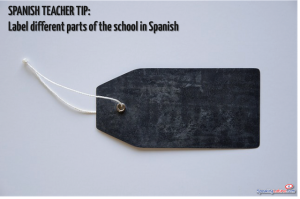
4. Label Different Parts of the School in Spanish
A fun activity to start the school year with is to take your students, go around the school in groups and have the students label the different parts of it with signs that show the word in Spanish, for example, gimnasio, fuente, baño (hombres / mujeres), puerta, escalera, etc.
This not only helps your students see Spanish all day, every day, but it also shows other kids in the school common Spanish words, so even if they aren’t in your class, they can begin to recognize Spanish.
If there’s not enough class time to do this, you can set this up before the students arrive for the year, and instead of letting them do it by themselves, just take them on a walk around the school and show them the already placed labels.
(I apologize here, but I can’t find in my notes who shared this fabulous Spanish teaching idea. If it was you, please email me to point it out!)

5. Encourage Spanish-Speaking Parents To Speak Spanish at Home
If you have students in your class with native parents (heritage students) be sure to spend some time discussing with those parents why they should speak Spanish at home. Surprisingly to me, it’s still common for parents to push away from their native language, mistakenly thinking that their son or daughter will be better off if they don’t speak Spanish.
We heard this from several teachers, so it is definitely something to tackle at the beginning of the year and reinforce with parents throughout the year.
If possible, you can even invite the parents to school (if they’d be willing to) to give a presentation to your students, or just have a conversation – although that might be better suited for more advanced students rather than beginners.
6. Songs in Spanish
As we heard from several teachers, music is a great way to keep kids engaged in class, teach them about culture and, at the same time, get them comfortable with listening comprehension. Not to mention, according to several studies, using music while learning can help students to memorize the material more easily.
Here is our list of songs to teach Spanish that we categorized by topic, along with links to the YouTube videos: Speaking Latino Spanish Song List. You can use any of these songs to create easy activities for your class.
One of the best music groups to use in Spanish teaching class is Kevin, Karla y la Banda. They actively record covers of top English songs in Spanish and upload lyrics videos to YouTube. Here are some examples of what kind of content they post:

7. Select Materials Based on What They Like, Rather Than What You Like
The next position on our list of tips for teaching Spanish is to select topics, songs and resources that your students will be interested in, NOT your favorite singers or topics.
Your students will be much more likely to pay attention and learn if you are teaching them about Daddy Yankee instead of Che Guevara, or using a Katy Perry song instead of a Luis Miguel song, especially at lower levels.
Michelle in Wisconsin shared that she has her students fill out a questionnaire at the start of school so she can tailor the topics and any prizes they earn based on their interests. This is a great idea as you can also ask them about the types of activities and exercises they prefer (playing board games, skits, role plays, etc.) and incorporate them into your Spanish teaching strategies.
Click here to receive the free questionnaire template and other materials for the beginning-of-the-year in your email.
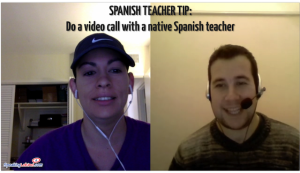
8. Do a Video Call With a Native Spanish Teacher
Looking for a unique experience for your kids? Consider hiring a teacher via italki or Skype to speak with them during one of your classes. It doesn’t even need to be any type of lesson or structured class – just a freely flowing conversation.
Giving them the opportunity to speak live with someone from another country, even if it is only asking questions in English, can be a great way to put them in contact with the rest of the Spanish-speaking world.

9. Expose Students To Current Events and News in Spanish
Finding resources in Spanish that beginning students can understand and follow can be difficult.
News In Slow Spanish may be an option for you, especially if you like to share current events.
There are two versions of this podcast: News in Slow Spanish where your students will hear the accent from Spain and News in Slow Latin Spanish with news discussed by native speakers from Latin America.
For students of all levels, incorporate the content from Pictoline. They release a visual every day about current events. These visuals are awesome because they have short texts in Spanish or no text at all. You can use them as conversation starters or ask their opinions about them.
Tip: Follow any of Pictoline’s social media accounts to receive the image daily.
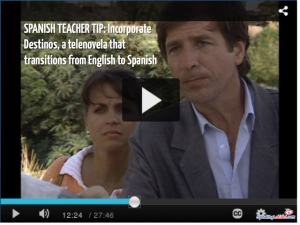
10. Incorporate Destinos, a Telenovela That Transitions From English To Spanish
The telenovela Destinos can be a fun way to introduce your students to Spanish. The first episode is in English and as the series advances, the episodes transition into all Spanish. Plus, the creators of Destinos also created a series of exercises that you may use along with the episodes.
This is a great resource for the days when you miss class and there’s a substitute teacher filling in. While it was made decades ago and the actors’ fashion and hair styles are out-of-date, it’s a great free resource to share with your students and keep them entertained, while they continue to learn.
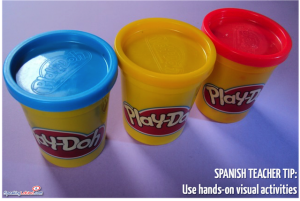
11. Use Hands-on Visual Activities
Carina from Michigan mentioned that she uses Play-Doh to have her students create objects while they learn vocabulary. The hands-on, visual activity can help them remember words. This is a great activity even for high school students. When was the last time they had a teacher that let them use Play-Doh in class? They’ll love it!
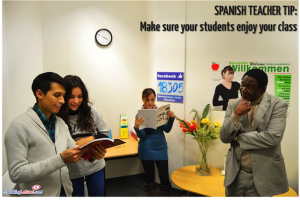
12. Make Sure Your Students Enjoy Your Class
Finally, the most important lesson we pulled from speaking with all the Spanish teachers is a simple one. Many of you don’t have enough time or resources to teach Spanish properly. Some of you only have your students for one hour a week, which means it is impossible to achieve any type of fluency with your kids.
You also sometimes face rigid requirements for topics to cover, textbooks or programs to use. Then many of you must focus on teaching Spanish so your students pass the end-of-year exam, even if the exam is not designed to test fluency. Basically, very few of you have the ideal situation to teach your students Spanish properly.
Based on this, our number one, most important recommendation for everyone teaching Spanish is that you make sure your students enjoy your class.
Even if they do not learn as much Spanish as you like, the most important thing they should take away from your class is a passion for Spanish. So even if they don’t have enough time to learn Spanish, they will walk away feeling happy about Spanish, and even perhaps with a hunger for learning more Spanish and other languages.
The Bottom Line
Thank you so much to the teachers who spent up to an hour speaking with us over the last few weeks, sharing wonderful ideas as well as frustrations that they experience.
While there’s no playbook on how to be a good Spanish teacher, taking advice from more experienced teachers can definitely help you when preparing Spanish teaching strategies that will keep your students engaged while also making the lessons insightful and informative.
Mucho éxito comenzando este nuevo año,
Jared and Diana